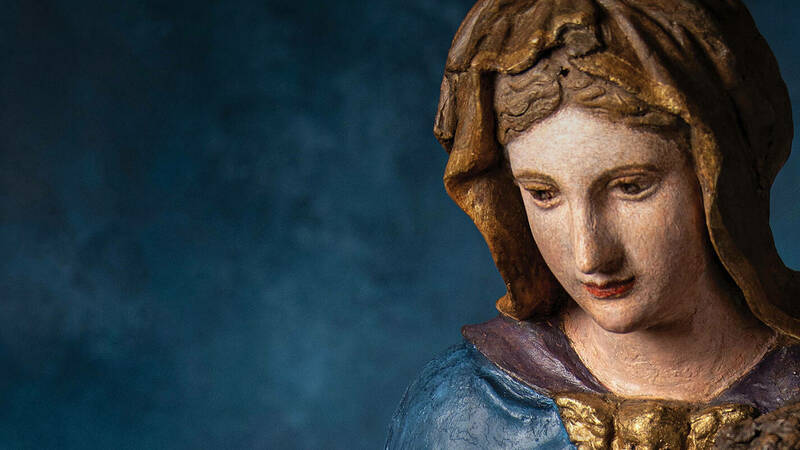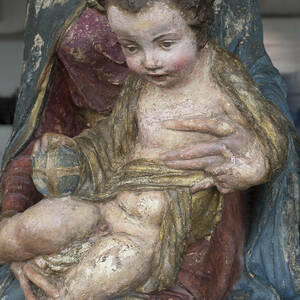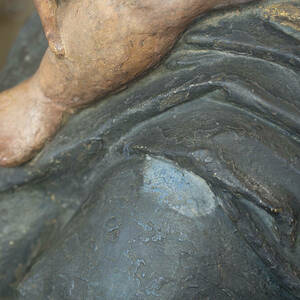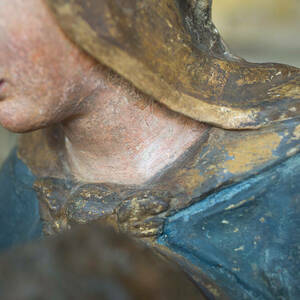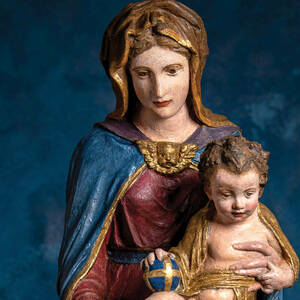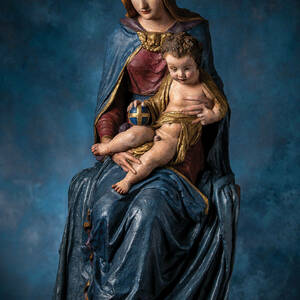She’s really not much to look at. Tired, ashen. Even seasick. That’s what I thought looking through a half-dozen photographs of a Madonna and child sculpture from Notre Dame’s Snite Museum of Art.
To be fair, I’d begun with the wrong image: the washed-out “before” pic. Shuffling through the work-in-progress shots, I saw paint being removed, the Virgin’s leprous complexion. She seemed downcast, unsure of her future.
The photos came to the magazine from Joseph Antenucci Becherer, the museum’s director. Humorous and lighthearted, he spoke infectiously at lunch one day about the construction along Eddy Street on the future home of Notre Dame’s storied collection, no longer to be called the Snite but the Raclin-Murphy Museum of Art. He also mentioned the sculpture that for years had stood at the entrance to the Snite before retiring to its Renaissance and Baroque gallery:
Madonna and Child
Jacopo Sansovino (studio of)
Italian, 1486-1570
stucco with polychrome
Gift of the Frederick B. Snite, Jr. family
There’s a story here, he said, of art, science and history, and where it all fits in his museum philosophy. When I asked for more, he said, “Talk to Cheryl,” handing me a business card for Cheryl Snay, curator of European art. “She’ll tell you everything you need to know.”
I whisked through the photos again, reconsidering my first impression, and then, the “after” shot: properly lit against a dark background — restored at considerable but unspecified cost. Laying the first and last photos side by side, the effect wasn’t evenhanded. It was like those weight-loss infomercials you see on off-peak TV.
Over the next three months, I visited the pensive lady and her squirming babe five times, learning about the things I could see — and lots more that I couldn’t. Start with the art.
Jacopo d’Antonio Tatti was the eldest of five children born into the modest home of a Florentine mattress maker. Michelangelo Buonarroti, 11 years older, grew up down the street. Jacopo’s mother encouraged his talent and apprenticed him to Andrea Sansovino, from whom Jacopo, in a move common among aspiring artists of the time, took the surname by which he is remembered.
He migrated between Florence and Rome, and before long Jacopo eclipsed his teacher and ascended into the highest circles of their discipline. “Few Italian Renaissance artists enjoyed as productive a career as Jacopo Sansovino,” writes art historian Bruce Boucher, who has declared him “Michelangelo’s most gifted rival.” As a rising-star sculptor and architect, Sansovino was good enough to have a falling-out with his more famous boyhood neighbor — and to win the admiration of Raphael.
Then, when Sansovino was 40, apparent catastrophe arrived in the form of an armed quarrel between the pope and the Holy Roman emperor. Rome was sacked, thousands were left dead in the streets and plague was breaking out. Everyone of note and of means fled.
Sansovino landed in Venice, a dynamo of international trade that had gotten a bit drowsy on the art scene. Luminaries of the maritime republic seized upon the artist’s skill and celebrity and soon appointed him chief architect of the city. Greater success ensued. Andrea Palladio, that genius of architecture’s classical revival, would praise Sansovino’s Biblioteca Marciana — the city’s public library, completed when the newcomer was 52 and really just warming up — as the best thing anyone had built anywhere in more than a thousand years.
“He really introduces, as an architect and sculptor, the Roman High Renaissance to Venice,” says Robert Coleman, the professor emeritus of art history who for decades taught Notre Dame’s course on the Italian art of the period. Sansovino was entrepreneurial, demanding, intolerant of rivals, original. A synthesizing master of both the emotionally charged mannerism of the generation chasing Michelangelo and the harmonious, orderly classicism favored in Rome, he quickly sized up the traditions of his new milieu, incorporating it all into a style he popularized through his hivelike studio.
In other words, for art and for Sansovino, the 1527 Sack of Rome wasn’t so bad after all. And in Venice, Coleman says, he had no competition.
Giorgio Vasari, who snubbed all Venice in the 1550 edition of his monumental Lives of the Most Excellent Painters, Sculptors, and Architects, righted that wrong in the 1560s after seeing the city beautified inside and out under Sansovino’s all-powerful hand. Vasari’s appraisal of the octogenarian expatriate filters Florentine snootiness through this newfound, grudging respect — and offers insight into the one piece of Sansovino’s corpus that would find its way to northern Indiana 450 years later:
Connoisseurs say that, however much he may have yielded the palm to Michelangelo, [Sansovino] was, nonetheless, his superior in certain things. In his drapery, in children, and in the demeanor of his female figures, Jacopo had no equal. . . .He made his children soft and tender without the musculature of adults and with little arms and legs, so lifelike that they seemed to be of flesh. The expressions of his women were sweet and charming, as graceful as could be. . . .
The Snite’s Madonna and Child is a case in point. Mistaken in 1921 by a scholar who believed it was a mockup for a prominent public commission, the plaster piece is instead a copy of that marble original made by an unidentified artist in Sansovino’s studio. Boucher makes this argument in his two-volume work, The Sculpture of Jacopo Sansovino, and Snay and Coleman affirm it. “Jacopo wasn’t a painter” or a plaster guy, Coleman explains. He was instead a peerless delegator and trainer of superior if unassuming talent — and Renaissance-era workshop culture was simply how loads of remarkable work got done.
Boucher’s scholarship on the Venice marble helps us understand the Snite stucco. Sometime in 1533-34, the three patroni of Venice’s Arsenale, the city’s leading employer, commissioned Sansovino to create a Madonna to fill an aedicule — a niche ornamented like a Roman temple — above the main entrance. This Virgin Mary, as patroness of Venice, would preside over its shipbuilding and military operations.
Sansovino’s marble composition was both literate and pioneering. Historians find precedent for the conspicuously large angel’s-head clasp of Mary’s cloak in the bronze that Donatello had sculpted for Padua’s Basilica of Saint Anthony 90 years earlier. And Boucher believes her downward focus, her loose hold on the Christ-child and the elaboration of her garments all seem too close to Michelangelo’s Madonna of Bruges “to be merely coincidental.”
At the same time, Sansovino set aside ideas about expression he’d learned as a young artist while seeking to meet Venetians’ more conservative expectations. And the gentle mother’s gaze has a practical aspect, too. You’re meant to meet it from below.
All of this is true about the Snite’s stucco Madonna, which likeliest was crafted for the home chapel of a wealthy private patron. It stands over three feet high, too big for a mantelpiece. And given its hollow back, it was probably placed against a wall, high up, for that same visual effect.
“It’s an interesting piece,” Coleman says.
We’ve met in the gallery on a snowy afternoon before Christmas to look at it together. “It’s of a really good quality” — and yet time, handling and the elements, he notes, have taken a toll. “The definition of the figure, the body, her hands, they’re pudgy and soft,” making it hard to see where artistic intention ends and multiple restorations across the centuries begin. Texturally, the flesh of mother and child appears coarse, giving Mary that figurehead quality I’d balked at in the documentary photos, as if she’d hung out on the prow of a wooden warship.
“Rustic” is the word I float to Coleman.
“I think what you’re saying is,” he patiently replies, “that just because the surface has probably been abraded and repainted” — through earlier conservation efforts, long before the sculpture came to Notre Dame — “it has a roughness about it. Where it might have originally tried to look marble-ish . . . it doesn’t have that shine anymore.”
Yes, thank you. That’s what I’m saying.
“So, we expect the Virgin Mary to be beautiful,” Robin Jensen explains further during a separate Snite visit in January. Jensen, a former illustrator turned art historian and Patrick O’Brien Professor of Theology, teaches students how to read sacred artworks as texts in courses with themes like Mary or The Cross. They select an object on campus and spend the semester with it, writing, say, a theological interpretation of the story depicted and a separate analysis of the object as art. The Sansovino Madonna is “very popular,” she says. “I often try to show them the 11th-century Madonnas where she’s solemn and remote. And it’s not what they want.”
Sansovino’s work is accessible, familiar: “There’s an introspection as if she’s . . . pondering things in her heart,” Jensen continues, thoughtfully. “She seems to be thinking, praying . . . and she’s not even looking at the baby.
“If this is an altarpiece, is she looking at the corporal? Is she thinking about the death of the child? . . . I’m being wildly speculative here.”
But speaking of the child, to whom our attention is guided by the golden hem of Mary’s mantel and the golden cross on Jesus’ ball, “He’s almost jumping off her lap. She’s having to hang on to him,” Jensen says. “He’s got a toy, but it’s also the world that he’s going to govern. So [you’ve] got the suggestion that this is the Lord of all the cosmos, but you also have this baby who’s actually playful.
“It’s really lovely. And I think that’s why our students are so drawn to it.”
Back in December, Coleman and I had retreated to a bench where he offered a slightly different interpretation: “Women nurture their babies in a number of ways. She’s not nurturing this child; she’s pushing him forward for you to see.”
That’s art. Whether or not it fulfills our notions of beauty, it says different things to different people. And what we see may change with time. With perspective.
“You know what?” Coleman paused. “The more I look at it, the nicer it gets.”
Joe Becherer wants the Raclin-Murphy to make the best possible impression when it opens in fall 2023. Arriving in 2018 from Grand Rapids, Michigan, where he taught art history at Aquinas College and oversaw sculpture at the gorgeous Meijer Gardens, he felt the Snite — with its modest visitor numbers — had become a “candle under a bushel.”
“There’s just so many wonderful objects that really deserve to be understood and celebrated,” he says, noting that 2024 will mark the collection’s 150th anniversary. The museum has a chance to refresh its reputation, which means the art must look its best: The Snite has roughly quadrupled its conservation spending, but funding is limited. Choices must be made.
An authority on modern and contemporary sculpture, Becherer recalled the Sansovino from visits as a graduate student. He understood its significance — a Renaissance-era Madonna and Child at Notre Dame, received as a door-opener from the Snite family when the expanded O’Shaughnessy Hall art gallery reopened as a museum in their name.
Now, though, Becherer is the man in charge, the caretaker respectful of the collection’s past and responsible to its future. “And originally I thought, well, maybe this isn’t something that should go into the new museum,” he recalls. “You put it next to something that has vibrancy and life, and how’s it going to hold up?”
But the Snite is not long on sculpture. And one day, while admiring a similar piece — recently restored — in another museum, Becherer had his epiphany.
Conservation done properly is where art meets science, and nowhere do they meet more beautifully than at ICA-Art Conservation in Cleveland, a nonprofit leader for 70 years. Senior conservator Andrea Chevalier, who took on the Sansovino project, knew she wanted to do this work as a teenager. She majored in art history, took two years each of studio art and chemistry, and worked professionally in her native Germany after graduate school. She’s restored everything from a fifth-century B.C. Egyptian coffin to contemporary pieces, with expertise in polychrome, or painted, sculpture.
The Sansovino Madonna became the star of her lab. “She sort of dominated the room,” Chevalier says. “You could walk around her,” so visitors could see how it was made and discover its mysteries: snippets of yellowed paper, many printed with Italian word fragments, stuck in the plaster on its backside; a faded Austrian customs stamp. And, Chevalier adds, “people could see the progression of the treatment as it went along.”
Task one was a painstaking examination of the sculpture’s condition, a lot of toil with small instruments under a microscope to inspect everything from the strength of the plaster to the paint-layer structure to the dust and nicotine that had all but infused into the surface. The plaster was in fine shape, so Chevalier’s report documents her focus on the polychrome, removing “small areas of overpaint” that revealed a few layers — evidence of previous restoration campaigns — and the uneven condition of the original paint. “When you start taking off that top paint layer, you get down to the bare plaster” in some places, she says, where the paint wore away over time, leaving the stucco vulnerable.
The faces and hands were scuffed and had an unpleasantly leaden hue. Chevalier’s guess is that the original artist applied an egg-white wash, which hardens as an insoluble sealant but grays with age, and that some would-be restorationist tried to scrub or scrape it off. That left Mary and Jesus looking poxy.
At a school preoccupied with learning and service, goodness and truth, it seems beauty, too, has an essential role to play.
What did the piece look like when Sansovino approved it? Online, Chevalier found a suitable comp at a museum in Madrid: The Annunciation, a two-piece sculpture in polychromed terracotta completed around 1535, which indicated similar color choices. Meanwhile, she sent four minuscule paint samples — two blues from Mary’s cloak, an orange and a red from her dress — to McCrone Associates, a Chicago-area microscopy lab, for analysis. Over a three-week period between Thanksgiving and Christmas, using micro X-ray diffraction to examine the crystal structure of each sample, and then a scanning electron microscope equipped with energy-dispersive X-ray spectrometry to determine the elemental composition, McCrone scientists ascertained the chemical identity of the pigments, essential information for an accurate restoration. “In brief,” Chevalier reported back, “azurite, vermilion” — blue and red pigments derived from copper and mercury — and “red lead and white lead were found.”
To be clear, the concern wasn’t potential toxicity but the closest-possible reproduction of 16th-century paint. The findings informed the conversation among Chevalier, Becherer and Snay about their goals for the Madonna and Child. “We didn’t want it to look brand new, because it is 500 years old,” Chevalier explains. “So we chose colors that we thought were close to the original colors with a somewhat aged appearance.”
Chevalier’s work had to be durable. Sansovino’s workshop used high-quality materials common at the time, “but you can’t forget that this was a devotional object. So it was probably touched. It may have been moved from inside to outside in processions,” the German citizen says, drawing from historical knowledge gained during her professional work in Europe.
She began treatment by “consolidating” loose paint with conservation-grade adhesives that her report footnotes down to their corporate source, removing excess fluid with cotton swabs. Cleaning compacted soot was another time-heavy task, easier on the sculpture’s hidden innards where she deployed a soft brush and vacuum. On the exterior, she used triammonium citrate, ammonia or acetone to remove dust and overpaint, depending on the color and chemical composition of the surface.
Unlike the clumsy restorations of ages past, the work also had to be reversible so future conservators have a better time of it. She gave the sculpture two coats of an isolating varnish — from which acrylic paints may be removed by people who know what they’re doing. Then she repainted the whole, applying thin washes of color based on the remaining islands of original paint.
This extreme makeover prompted discoveries. Snay consulted with a typographical historian about the shredded paper, but no samples were large enough for a positive dating. Then, during a visit to ICA, a research associate, Catherine Kupiec, found indentations one-eighth of an inch deep on Mary’s cloak at her knees. They’re not insect holes or natural damage, Snay says. “The guess — and this is purely a guess,” she cautions, “is that somebody may have tacked prayer petitions to it.”
There’s also the small, hand-forged nail in Mary’s forehead. Snay told Chevalier not to remove it, “because I like it to be evidence of this kind of engagement with the object.” The hardware, and quarter-inch holes in the tops of both heads — Mary’s open but Jesus’ filled — suggest to Snay they once had diadems affixed to them.
What about the customs stamp on the board that battens the sculpture at its base? The ink is nearly illegible, but between Chevalier’s language proficiency and a friend who conserves furniture in Vienna, she determined it should read “vom Bundesdenkmalamt zur Ausfuhr freigegeben” — approved for export by the Federal Monuments Office. It’s impossible to date the stamp, which is still used today.
“Andrea is so smart and so sensitive,” says Becherer, the very picture of a satisfied customer. “And she has the most amazing eye. She’s like an eagle.”
The Snite Museum of Art opened in November 1980 to enormous fanfare. The art critic of Time magazine anchored a panel about the future of collecting. Father Ted Hesburgh, CSC, the University president, awarded honorary degrees and prayerfully dedicated Sansovino’s Madonna and Child before the museum opened to the public.
Somehow it still got lost in all that shuffle. Newspaper stories all carried the same sentence about it, lifted from a press release, before whole paragraphs about the man in whose memory it was dedicated: Fred Snite ’33, a devout Catholic who had contracted polio, lived in an iron lung, got married, had kids and lived a short but goodhearted life.
No doubt the opening-day throng was more eager to see the paintings on loan by Renoir, Picasso and van Gogh than the work of a sculptor whose name most people don’t know. In time, the Virgin became . . . familiar. She appeared on a Christmas card. Eventually overexposure forced her into the Renaissance/Baroque gallery, where she meekly blended into the museum’s important and extensive collection of sacred art.
So began the Notre Dame chapter of what Cheryl Snay refers to as the “social life of things,” the way an object interacts with its environs. Every encounter with a work of art “modifies it to a certain extent,” she says. “How people used it; how people regarded it.”
What happened between Sansovino’s workshop and the Snite is a story no one has fully pieced together. The sculpture’s whereabouts from the 1530s to 1900 are unknown, at which point it gets caught up in a misty whirlwind of 20th-century history, buffeted by Depression, war, the fall of the Third Reich and the rise of the sumptuous, stuffy London gallery scene of the 1970s. Boucher’s book has only this to say about these dark ages of its pre-Notre Dame provenance:
Dr Hermann Eissler, Vienna; Baron von Sobek, Vienna; Heim Gallery, London
The son of a Jewish timber magnate, described by a friend as “a funny little oaf who liked to joke just as much as he put up with the friendly taunts of others,” Hermann Eissler took advantage of his family’s wealth in the late 19th century to earn a doctorate in Alpine geology before taking over the firm and building one of Europe’s best-known art collections. Acquisitions slowed when World War I soured the company’s fortunes; Eissler reset his sights on a comfortable retirement, converting to Catholicism in 1927 and marrying a much younger Catholic woman in 1929, when he was 69 years old.
When exactly Sansovino’s Madonna passed out of his hands is unknown. Already in 1932, Leo Planiscig, a Sansovino expert, noted “the accelerated dispersal of private holdings of various European Jewish or otherwise pressed collectors,” due presumably to financial distress. But according to historians Alexandra Caruso and Anneliese Schallmeiner, the rise of antisemitism — and Nazi Germany’s annexation of Austria in March 1938 — spelled the true end of Eissler’s “almost mythic” collection. The Eisslers “divorced” and transferred some valuables into Hermann’s ex-wife’s possession. (Hortense Eissler is known to have had success removing items from Austria in defiance of Nazi export laws; the couple remarried in 1948.) Eissler himself may have escaped the Nazi death camps by selling off pieces to support his wartime exile in Nice.
Meanwhile the Nazis, working through the Austrian monuments office and a Vienna magistrate, seized everything else. Much of it wound up in Austrian museums. Whether the Sansovino Madonna was one such piece is a mystery potentially solvable by reviewing the Nazis’ obsessive documentation of their systematic thefts.
The sculpture next surfaces in the possession of Franz Sobek, whose involvement in Austria’s fascistic Fatherland Front put him on the wrong side of the German occupation after 1938 and landed him in Dachau for two years. He later became a leader of the Austrian resistance and, after the war, the effort to restore rights to victims of political persecution. A public figure until his death in 1975, Sobek purchased a mansion near Vienna that housed his notable collection of handmade clocks and would bequeath both to the national museum system.
In 1972, according to correspondence archived at the Getty Research Institute, Sobek wrote to Andrew Ciechanowiecki, the director of the London offices of the Paris-based Heim Gallery. A Polish expatriate of aristocratic lineage and noted expertise in European sculpture, Ciechanowiecki entered what one writer has called “the genteel atmosphere of the London art scene” as a kind of Cold War espionage figure, a hero of the 1944 anti-Nazi Warsaw Uprising later imprisoned for six years by Poland’s communist government as an alleged agent of the United Kingdom and the Vatican. He took charge of Sobek’s Sansovino Madonna as a selling agent, and the long hunt for a buyer began.
The Heim cultivated ties with American museums, particularly in the Midwest, a keen market. Notre Dame bought two important pieces from Ciechanowiecki in 1971. “I knew the guy,” says Dean Porter, then a Notre Dame curator, noting the difficult pronunciation of the late connoisseur’s surname. “People always said, ‘Just call him Chicken and Whisky.’”
In 1980, Porter, by then the Snite’s director, and his predecessor, Rev. Anthony Lauck, CSC, ’42, wrote to their man in London for help finding a “Virgin Mary or Virgin and Child for special placement near the entrance of the new museum.” Lauck admitted that the $90,000 the Snites were willing to spend was a “rash” amount to budget at the time for a “very good sculpture . . . but perhaps we shall be lucky.” Ciechanowiecki proposed Sansovino’s lady.
Peter Sobek knew little about his father’s Madonna. He told Ciechanowiecki that the family had owned it since about 1930 and had not modified it in any way. Later he recalled his father buying a Madonna through a Professor Eigenberger. It may have been the Sansovino sculpture — or another piece. But this association with Robert Eigenberger meant Franz Sobek the Nazi resister had worked closely at one time with a prominent Austrian Nazi: Eigenberger was the artist and scholar in charge of the picture gallery of Vienna’s Academy of Fine Arts before, during and after World War II. He was responsible for removing and thus protecting its priceless holdings from Allied air raids.
The story of Jacopo Sansovino’s Madonna and Child remains as obscure during the 1930s as it is from the 1530s.
What’s her future?
Cheryl Snay says the piece holds “pride of place” in her proposal for Raclin-Murphy galleries organized less around chronology or national school than on themes that illustrate strengths of the European collection. If her plan — which aligns with emerging interpretive practice — is approved, the Madonna and Child will preside over a gallery showcasing the iconography of the Virgin. Andrea Chevalier is conserving two additional pieces that might go with her or into similar displays. Snay wants visitors to contemplate them sensorially, materially, “how they help the spectator achieve a religious experience.” To understand what makes “especially Catholic images Catholic.”
Notre Dame’s art collection under any name has many strengths: African, Mesoamerican, Native American; the decorative arts, photographs and drawings; works old and new. Snay and Becherer say their vision may help Notre Dame figure out “what it means to have an art museum on the campus of a Catholic university in the 21st century,” one that helps fulfill the academic mission.
“We are bringing into the academy the most visually aware generation that has perhaps ever existed,” Becherer says. The arts can harness that awareness to foster dialogue across divisions of creed. At a school preoccupied with learning and service, goodness and truth, it seems beauty, too, has an essential role to play. Says its chief caretaker at Notre Dame, “Catholics and art go together, you know?”
John Nagy is managing editor of this magazine.
